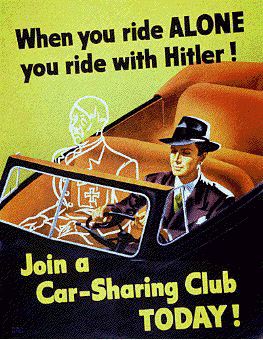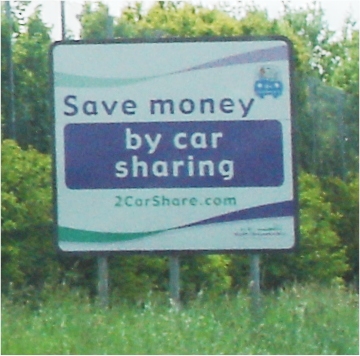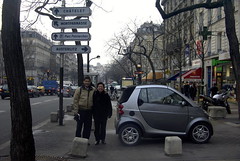Changing Times
 U.S. "war at home" poster from 1942. Gasoline rationing during WWII was not about oil supplies but the need to conserve rubber (tires) since access to rubber plantations in South Asia was cut off by the war.
U.S. "war at home" poster from 1942. Gasoline rationing during WWII was not about oil supplies but the need to conserve rubber (tires) since access to rubber plantations in South Asia was cut off by the war.A column by Cato Institute researcher Alan Reynolds says that "only" 40% of gasoline is used for driving automobiles, and that 58% of a barrell of oil is used for the production of gasoline. So, roughly 20% of oil consumed in the United States is for automobile driving.
 Car Sharing Road Sign -- UK, from the UK Government Car Sharing Campaign. Flickr Photo by Bart Macguire.
Car Sharing Road Sign -- UK, from the UK Government Car Sharing Campaign. Flickr Photo by Bart Macguire. Smart Car in Paris, photo by "Mariana" a student at Duke.
Smart Car in Paris, photo by "Mariana" a student at Duke.In "Smart Cars Needed but wouldn't stand a chance" Washington Times columnist Afrienne Washington says that smart cars are a good idea but "A European Smart Car wouldn't stand a chance here, I thought. It would be smashed like a ladybug within two seconds on the Beltway. However, Smart Cars are just what we need in an area that is becoming the nation's capital of gas-guzzling SUV gridlock." All in all, she wrote a very good column.
I don't understand why the Smart Car and the Minis from BMW don't develop specific urban marketing campaigns and city-based dealerships. A Smart car doesn't need to drive on the Beltway and compete with all that traffic, but for people needing to make the transition from auto-centricity to urban living, it's a viable option.



0 Comments:
Post a Comment
<< Home